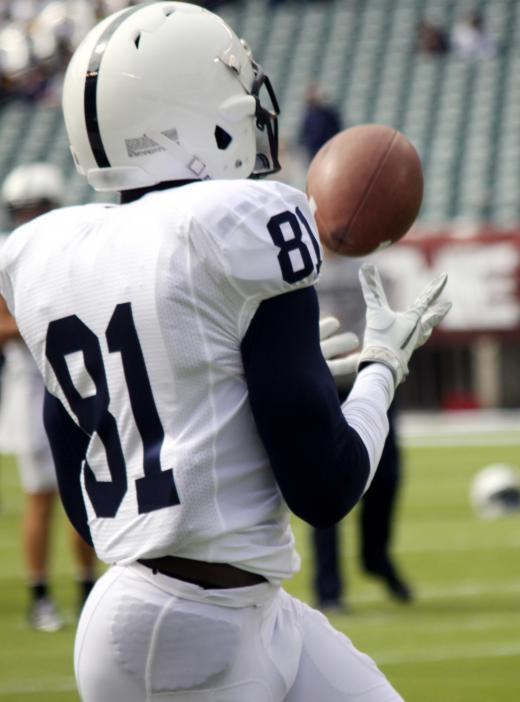At Sports&Hobbies, we're committed to delivering accurate, trustworthy information. Our expert-authored content is rigorously fact-checked and sourced from credible authorities. Discover how we uphold the highest standards in providing you with reliable knowledge.
What is a Two-Point Conversion?
A two-point conversion is a tactic used in American and Canadian football to score two additional points after scoring a touchdown, which is worth six points. When a team scores a touchdown, it has the option of kicking the football through the goal posts for one point — usually called an extra point, point after touchdown (PAT) or conversion kick — or it can attempt a two-point conversion by trying to run or pass the ball into the end zone from a short, predetermined distance. For college and professional teams, which generally have somewhat reliable kickers, the chances of being successful on a two-point attempt are much less than the odds of making an extra-point kick, but the additional point earned by a successful two-point conversion can be worth the gamble in certain situations. The decision to "go for two" is a matter of strategy, and success or failure can sometimes mean the difference between winning or losing a game.
Rules Vary by League

The rules for conversions after touchdowns vary in different leagues and levels of football. In college football and most high school leagues in the United States, a two-point conversion must be attempted from a distance of 3 yards (2.74 m) away from the end zone. A two-point attempt in the National Football League (NFL) comes from 2 yards (1.83 m) away from the end zone. In the Canadian Football League (CFL), the attempt is from the 5-yard (4.57-meter) line.

Some youth football leagues reverse the points awarded, giving teams one point for running or passing for a conversion and two points for a kick, because kicking the ball through the goal posts can be very difficult for young players. Other youth leagues award two points for a pass or kick and one point for a run. Various other rules and modifications have been used by both professional and amateur leagues. In some leagues or levels of football, the defensive team can even score two points on a conversion attempt by gaining possession and returning the football into the opposite end zone.
The two-point conversion has not always been part of the rules of football. It was adopted in U.S. college football in 1958 with the intent of reducing the number of tie games. The NFL adopted the two-point conversion in 1994.
Statistics Not Counted

When a team attempts a two-point conversion, the statistics achieved on the play — such as a pass attempt, completion or interception — usually are not included in the statistics for the game. This is because the attempt essentially is considered an extra play from scrimmage and not a normal play. In such cases, the only thing that matters is whether the offensive team successfully ran or passed the ball into the end zone — or, if the rules allow, whether the defensive team took the ball away and returned it for its own two-point conversion. Also, the game clock does not run during the conversion attempt.
Strategy Involved
Strategy usually comes into play when a coach considers whether to kick an extra point or go for two. The coach must consider the score of each team, the time remaining in the game and the likelihood of either team scoring more points in various quantities. To help sort through the possibilities and simplify the decision, many coaches use a chart that tells them when to try a kick or go for two, based on the difference between the teams' scores after the touchdown. Most coaches, especially at the higher levels of football, where kickers are more reliable, choose to kick an extra point in almost all cases until the fourth quarter of a game or even until the final few minutes.
Sample Strategies
Although there are multiple versions of the chart that coaches use to decide whether to go for two or kick an extra point, the charts typically are identical for most situations. For example, when a team scores a touchdown to go ahead by five points, the chart advises the coach to go for two in order to take a seven-point lead — the points awarded for a touchdown and extra-point kick — if the attempt is successful. When a team scores a touchdown and still trails by nine points, some charts advise the coach to go for two to reduce its deficit to seven points if the attempt is successful. If a touchdown leaves a team behind by four points, some charts specify that the decision is up to the coach — a successful conversion would leave the team behind by only two points, and a field goal, which is worth three points, might be enough to win the game. A failed conversion, however, would leave the team behind by more than one field goal and needing a touchdown or two field goals to take the lead.
AS FEATURED ON:
AS FEATURED ON:













Discussion Comments
why is it not counted a completion, incompletion or interception.
NO, he is not. The pass is not counted in his passing statistics, either.
In the NFL when a team goes for a two point conversion and the defense intercepts the ball, is the QB charged with an interception on the play?
Walt
Post your comments